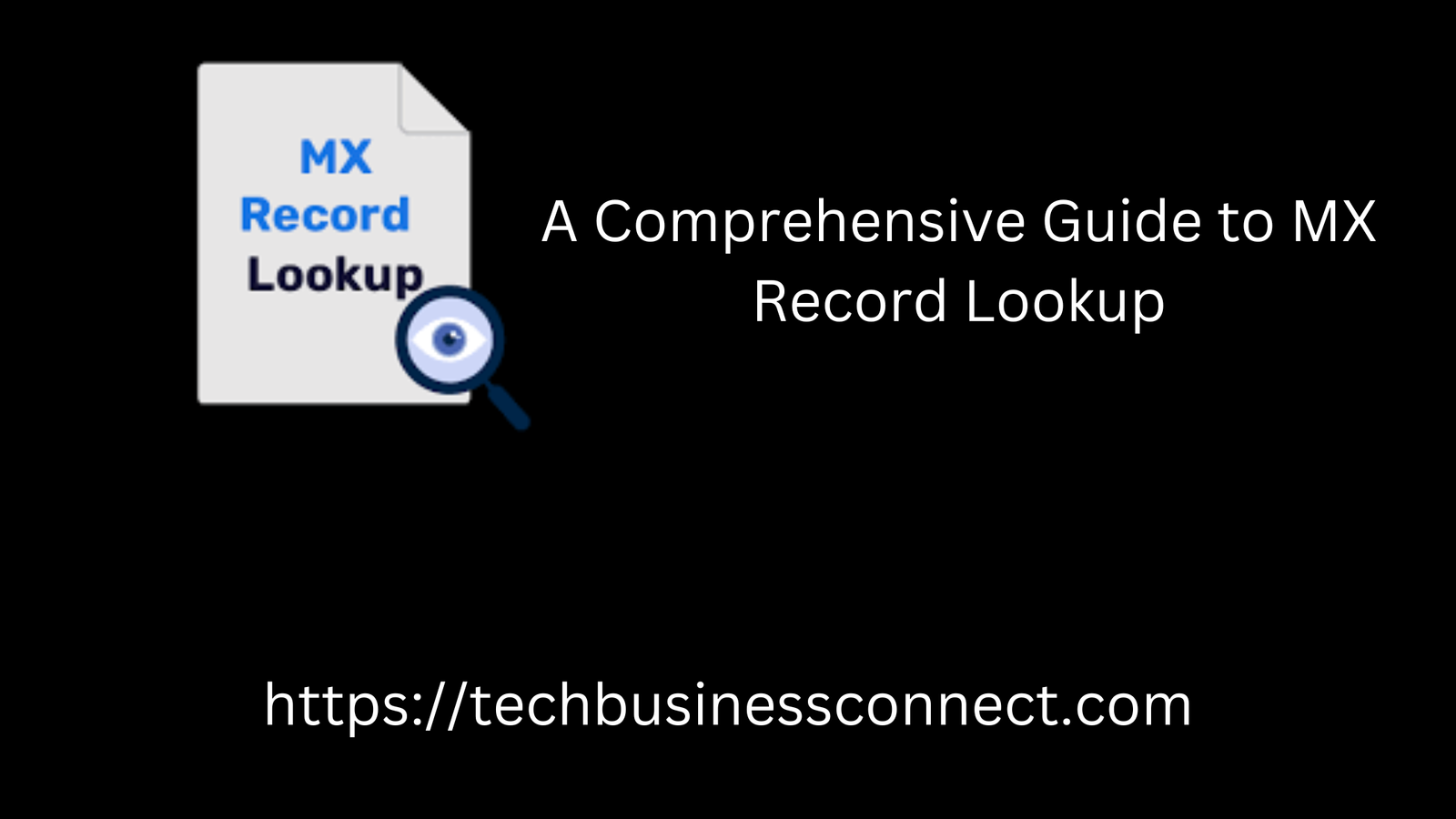
A Comprehensive Guide to Lookup MX Record 2024
Lookup mx record in the digital age, the smooth functioning of email systems is integral to business operations and personal communications. The email system, though seemingly straightforward from a user’s perspective, is built on a complex infrastructure. At the heart of email delivery lies the Mail Exchange (MX) record, a critical component in the Domain Name System (DNS) that directs email traffic. Understanding how to look up MX records, why they matter, and what they signify is crucial for anyone involved in network administration or email management.
This article provides a comprehensive guide to lookup mx record, diving into the mechanics of MX records, their importance, and how to perform a lookup using various methods.
What Is an Lookup MX Record?
Lookup MX record, short for Mail Exchange records, are DNS entries that specify the mail servers responsible for receiving email on behalf of a domain. When an email is sent, the sending server queries the DNS of the recipient’s domain to find the appropriate mail server for delivery. The MX record not only provides the server’s address but also assigns priority to each mail server in case there are multiple options available.
MX records contain two key pieces of information:
- Priority Value: A number indicating the priority of the mail server. Lower numbers indicate higher priority.
- Mail Server: The fully qualified domain name (FQDN) of the mail server responsible for receiving the email.
For example, the lookup mx record for a domain might look like this:
Copy code10 mail.example.com
20 backupmail.example.com
In this example, mail.example.com is the primary mail server with a priority of 10, and backupmail.example.com is the secondary mail server with a priority of 20.
Why MX Records Are Important
Lookup MX record are vital to email functionality. If MX records are misconfigured, emails sent to a domain could fail to be delivered, leading to significant communication issues for businesses and individuals alike. Understanding MX records can help in diagnosing email delivery problems, ensuring redundancy, and optimizing the performance of an email system.
Some of the main reasons why MX records are crucial include:
1. Directing Email Traffic
When someone sends an email, the sending mail server needs to know where to deliver it. MX records provide this direction, ensuring that the email is sent to the correct destination.
2. Ensuring Redundancy
MX records allow for multiple mail servers to be listed, ensuring that if the primary server is down or unavailable, the email can still be delivered to a backup server. This redundancy is crucial for businesses that need reliable email communication.
3. Managing Email Load
By assigning different priority values to multiple servers, MX records can help distribute email traffic across several servers, preventing overload on a single server and optimizing the performance of an email system.
4. Security
Proper configuration of MX records can also contribute to email security. By setting up secure mail servers and prioritizing them properly, organizations can reduce the risk of email spoofing, spam, and phishing attacks.
How Lookup MX Record Work
To understand how lookup MX record work, it’s important to grasp the process that occurs when an email is sent:
- Sender Queries DNS: When an email is sent, the sender’s mail server queries the DNS for the MX records of the recipient’s domain.
- DNS Returns MX Records: The DNS returns a list of mail servers, ordered by priority.
- Mail Delivered to Highest Priority Server: The sending server attempts to deliver the email to the highest priority server (lowest MX value).
- Fallback to Backup Servers: If the primary server is unavailable, the sending server tries the next server in line, based on the priority values in the MX records.
This process ensures that email delivery is reliable, even if some mail servers experience downtime.
How to Lookup MX Records
There are several methods to look up MX records. Each method may suit different needs based on user preference, the operating system in use, or the depth of information required. Here, we’ll explore several popular ways to look up MX records.
1. Using Command Line Tools
For those comfortable with the command line, there are several tools available that can be used to perform an MX lookup. Below are instructions for using a few of these tools.
a. nslookup
nslookup is a command-line utility available on most operating systems. It can be used to query DNS information, including MX records.
Steps to use nslookup for MX lookup:
- Open the command prompt (Windows) or terminal (Mac/Linux).
- Type the following command:bashCopy code
nslookup -type=mx example.comReplaceexample.comwith the domain you want to query.
The output will display the MX records for the specified domain, including the priority values and mail server addresses.
b. dig
dig (Domain Information Groper) is a powerful DNS query tool that provides detailed information about DNS records.
Steps to use dig for MX lookup:
- Open the terminal (Mac/Linux). On Windows, you may need to install
dig(part of BIND tools). - Type the following command:Copy code
dig mx example.comReplaceexample.comwith the domain name.
The output will include the MX records along with other useful DNS information.
c. host
The host command is another simple tool available on Unix-based systems (Linux/Mac). It’s more lightweight than dig and provides MX record information quickly.
Steps to use host for MX lookup:
- Open the terminal.
- Type the following command:Copy code
host -t mx example.comReplaceexample.comwith the domain you want to query.
2. Using Web-Based MX Lookup Tools
For users who prefer a graphical interface or need a quick solution without using the command line, there are numerous online tools available for MX record lookup. Some of the most popular tools include:
- MXToolbox (https://mxtoolbox.com/): One of the most widely used online tools for looking up MX records. Simply enter the domain name, and it will display all associated MX records.
- DNSstuff (https://www.dnsstuff.com/): Another robust tool for querying DNS information, including MX records.
- WhatsMyDNS (https://www.whatsmydns.net/): This tool allows users to check DNS propagation across multiple locations, making it particularly useful for tracking changes in MX records.
3. Using DNS Management Tools
If you manage a domain through a hosting provider, their control panel likely offers DNS management tools that allow you to view and edit MX records. For example, services like GoDaddy, Namecheap, and Cloudflare offer DNS management interfaces where you can view and modify MX records.
4. Using Email Client Diagnostic Tools
Some email clients, such as Microsoft Outlook, offer built-in diagnostic tools that can display MX record information. This is particularly useful if you are troubleshooting email delivery issues.
Interpreting MX Lookup Results
Once you’ve performed an MX lookup, you’ll receive a list of MX records. It’s important to know how to interpret this information.
- Priority: The number indicates the priority of the server, with lower numbers having higher priority.
- Mail Server: The server to which emails will be sent. It’s crucial to ensure these are correct, as a misconfiguration can lead to emails being lost or undelivered.
- TTL (Time to Live): This is a value (usually in seconds) that indicates how long the DNS resolver should cache the MX record before querying the DNS again.
Common MX Record Issues
While MX records are generally reliable, there are a few common issues that can arise:
- Misconfigured Records: Incorrect priorities or incorrect mail server addresses can lead to email delivery failures.
- Missing MX Records: If a domain has no MX records, email cannot be delivered. In such cases, email servers may attempt to send the email to the A record (the domain’s primary IP), but this is not a recommended setup.
- High TTL Values: If the TTL is set too high, changes to MX records might take longer to propagate, which can delay the resolution of issues.
Conclusion
MX records are a fundamental part of the email infrastructure, ensuring that emails are directed to the correct mail servers. Knowing how to look up MX records and understanding their structure is essential for network administrators, IT professionals, and anyone involved in managing a domain’s email systems. Whether using command-line tools like nslookup or dig, or web-based tools like MXToolbox, performing an MX lookup is straightforward and can provide valuable insights into the health and configuration of your email services. Proper management and troubleshooting of MX records can enhance email reliability, security, and performance.


